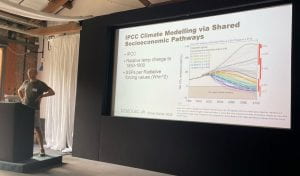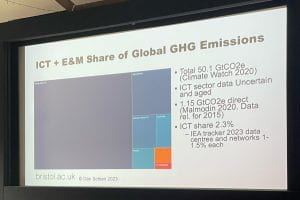This blog post is written by AI CDT student Phillip Sloan
After a great presentation by Dr Dandan Zhang, Dr Daniel Schien presented a keynote on the Carbon Footprint of AI within global carbon emissions of ICT, the presentation provided a reflection on AI’s role within climate change.
The keynote started by stating the effects of climate change are becoming more noticeable. It’s understandable that we might get numb from the constant barrage of climate change reports in the news, but the threat of climate change is still present and it is one of the biggest challenges we face today. As engineers, we have a duty to reduce our impact where possible. The Intergovernmental Panel on Climate Change (IPCC) is trying to model the effects of global climate change, demonstrating many potential futures depending on how well we limit our carbon emissions. It has been agreed that we can no longer stop climate change, and the focus has changed to trying to limit its effect, with an aim to have a global temperate increase of 2 degrees. The IPCC has modelled the impact until 2100, across various regions and modelling a range of impact areas.

Currently the global emissions are approximately 50 gigatonnes of equivalent carbon dioxide (GtCO2e), which needs to be reduced significantly. This is the total consumption, including sections such as energy production, agriculture and general industry. Many governments have legislated carbon consumption. Introducing CO2 emission standards for cars and vans, renewable energy directives, land use, and forestry regulation. The main goal is a 50% reduction in carbon emissions until 2030.

ICTs share of global green house gas (GHG) emissions is 2.3%. With data centres, where a lot of AI algorithms are run, creating a large proportion of these emissions. Do we need to worry about AI’s contribution to climate change? The keynote highlighted that 20-30% of all data centre energy consumption is related to AI, and looking at just the ChatGPT model, its energy consumption its equivalent to the consumption of 175,000 households! These figures are expected to get worse, with the success of AI causing an increase in demand, further impacting AI’s energy consumption. The keynote highlighted that the impact of AI is not just from the training and inference, but also from the construction of the data centres and equipment, such as graphics cards.
A conceptual model was presented, modelling the effects of ICT on carbon emissions. The model described three effects that ICT has on carbon consumption. These are direct effects, enabling (indirect) effects and systemic effects. Direct effects are related to the technology that is being developed , its production, use and disposal. Enabling effects are related to its application, providing induction and obsolescence effects. Systemic effects are related to behavioural and structural change from utilising these applications.

So, what can be done to reduce the environmental impact of AI? In the development of AI systems, efficiency improvements such as utilising more energy efficient models and hardware that reduces the energy consumption, and improving the carbon footprint. Using green energy is also important on your carbon footprint. Dr Schien notes that the UK has acted upon this, implementing regulation to promote wind and solar energy with a hope to decarbonise the electric grid. The average gC02e/kWh has moved from around 250 down to 50, showing the UK governments efforts to impact climate change.

Despite its significant energy consumption, AI can be used to make systems more efficient, reducing the energy consumption of other systems. For example, AI-powered applications can tell the power systems to switch to using the batteries during times when tariffs are higher (peak load shifting), or when the grid power usage reaches a certain power grid alternating current limit (AC limit).
During the Q&A, an interesting question was put forward asking at what point should sustainability be thought of? When developing a model, or further down the pipeline?
Dr Schien answered by mentioning that you should always consider which model to use. Can you avoid a deep learning model and use something simpler, like a linear regression or random forest model? You can also avoid waste in your models, reducing the number of layers or changing architectures would be useful. Generally thinking about only using what you need is an important mindset for improving your AI carbon footprint. An important note was that a lot of efficiencies are now being coded into frequently used libraries, which is helpful for development as it is now automated. Finally, seeking to work for companies that are mindful of energy consumptions and emissions will put pressure on firms to consider these to attract talented staff.
Dr Daniel Schien is a senior lecturer at the University of Bristol. His research aims are focused on improving our understanding of the environmental impact from information and communication technologies (ICT), and the reduction of such impact. We would like to thank him for his thoughtful presentation into the effect of AI with regards to climate change, and the discussions it provoked.
